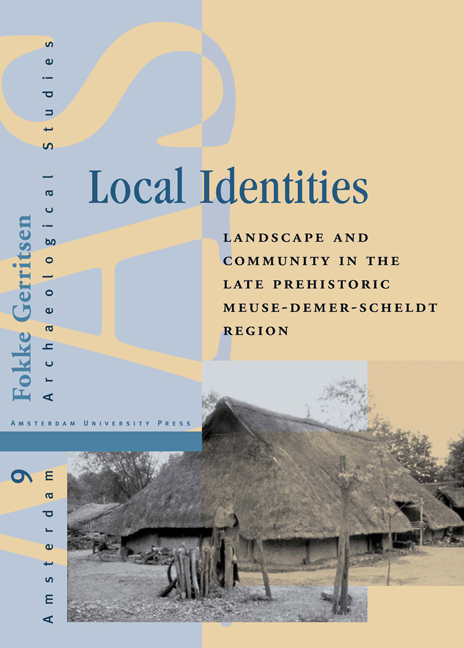Book contents
- Frontmatter
- Contents
- Acknowledgment
- 1 Introduction
- 2 Archaeology in a Sandy ‘Essen’ Landscape
- 3 The House and its Inhabitants
- 4 Local Communities and the Organisation of the Landscape
- 5 Micro-Regional and Regional Patterns of Habitation, Demography and land use
- 6 Landscape, Identity and Community in the First Millennium BC
- Abbreviations
- References
- Appendix 1 Meuse-Demer-Scheldt Region. Distribution of Urnfields
- Appendix 2 Catalogus of Urnfields
- Index of Geographical Names
3 - The House and its Inhabitants
Published online by Cambridge University Press: 28 January 2021
- Frontmatter
- Contents
- Acknowledgment
- 1 Introduction
- 2 Archaeology in a Sandy ‘Essen’ Landscape
- 3 The House and its Inhabitants
- 4 Local Communities and the Organisation of the Landscape
- 5 Micro-Regional and Regional Patterns of Habitation, Demography and land use
- 6 Landscape, Identity and Community in the First Millennium BC
- Abbreviations
- References
- Appendix 1 Meuse-Demer-Scheldt Region. Distribution of Urnfields
- Appendix 2 Catalogus of Urnfields
- Index of Geographical Names
Summary
AN ANTHROPOLOGICAL PERSPECTIVE ON HOUSES AND HOUSEHOLDS
INTRODUCTION
To say that a house is more than a physical shelter against the elements is simply pointing out the obvious. Houses are in many ways at the heart of social and cultural life, both in non-modern societies and in present-day, western society; they ‘constitute culturally significant space of the highest order’. In contemporary northwestern Europe houses are embedded in a web of diverse notions including home, family, privacy, investment, status and the like. The significance of houses in other societies may well be based on wholly different ideas, but houses are never socially or symbolically neutral. Le Roy Ladurie notes about the 13th century Pyrenean village of Montaillou that
…the best way to understand Montaillou is to abandon temporarily the problems of social stratification within it and go straight to the basic cell which, multiplied a few dozen times, went to make up the village.This basic cell was none other than the peasant family, embodied in the permanence of a house and in the daily life of a group co-resident under the same roof. In local language this entity was called an ostal; and in the Latin of the Inquisition files it was called a hospicium or, more often, a domus. It should be noted that the words ostal, domus and hospicium all and inextricably mean both family and house.The term familia is practically never used in the Fournier register. It never crosses the lips of the inhabitants of Montaillou themselves, for whom the family of flesh and blood and the house of wood, stone or daub were one and the same thing.
The ethnographic literature is rich with examples that show how houses are invested with social and symbolic meanings in a great variety of ways.The identification of a house with its inhabitants is a recurrent element in the ethnographic literature (particularly but not only in societies that lack a commercial house market), but it is only one possible aspect. Houses can be reflections and structuring features of socio-cosmological orders. They can provide the context for a particular ‘dwelling-habitus’ consisting of cultural ideas and values that structure daily life in and around the house.
- Type
- Chapter
- Information
- Local IdentitiesLandscape and Community in the Late Prehistoric Meuse-Demer-Scheldt Region, pp. 31 - 108Publisher: Amsterdam University PressPrint publication year: 2003



